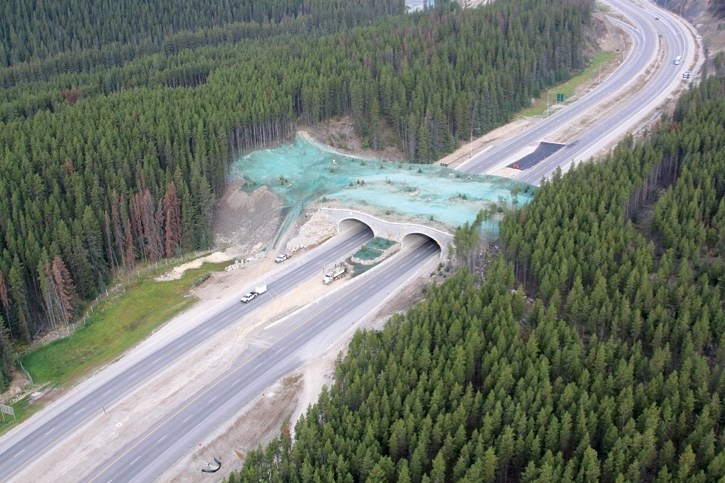While there were no big bucks in the provincial budget for construction of a wildlife overpass across the busy Trans-Canada Highway at Bow Valley Gap, a planning study and design process is soon to be underway.
The province has dollars to hire a consultant this year to do the design and cost benefit analysis of the structure, expected to cost about $7 million to build. It's to be located between Highway 1X and Lac Des Arcs.
“The consultant will look at the cost effectiveness of a wildlife overpass in regards to the location and general topography and make recommendations for the most appropriate type of structure for an overpass,” said Alberta Transportation spokesman Wayne Wood.
“Until we know what type of overpass is recommended, construction will remain unfunded.”
Yellowstone to Yukon (Y2Y) Conservation has been pushing for the structure for many years.
“They haven't put down millions of dollars for the structure, but their intent is to move this project forward,” said Stephen Legault, a program director with Y2Y. “It's definitely good news. We are absolutely thrilled about this.”
With development proposals in the Bow Valley, from Three Sisters Mountain Village and SilverTip, and ongoing concerns about wildlife movement conflicting with increasing human use, there have been ongoing calls for this overpass.
Banff Lake Louise Hospitality Association has joined the voices calling for the overpass.
The group has fired off a letter to Premier Rachel Notley, saying an overpass in this location is a unique opportunity to build on the success of a network of overpasses and underpasses in Banff National Park.
“We call on the Government of Alberta to act quickly on this initiative, as it will meaningfully contribute to human and wildlife safety in one of the province's most iconic tourism regions,” said Darren Reeder, the group's executive director.
“It needs to be built.”
The Trans-Canada Highway has been identified as barrier to wildlife movement and a source of mortality for wildlife in the region. It's not just ungulates getting hit, but also grizzlies, black bears, coyotes and wolves.
In 2012, a highway mitigation plan was developed for a 39-kilometre stretch of highway between Canmore and Highway 40, where there are only two underpasses with wildlife fencing over a three-km stretch near Dead Man's Flats.
At that time, the study estimated there to be about 60 collisions with deer, moose, sheep and elk per year, which added up to almost $750,000 in costs to mitigate collisions, such as clean up and insurance costs.
Reeder said there are close to 25,000 vehicles per day that travel the Trans-Canada Highway inside and outside Banff National Park.
He said the science-based results in Banff have been outstanding, noting highway fencing reduced wildlife-vehicle collisions by more than 80 per cent and, for elk and deer alone, by more than 96 per cent.
“There has been numerous international studies on the benefits of wildlife overpasses and fencing,” he said. “They include increased motorist safety; significant reduced costs related to insurance claims and health care costs; wildlife protection; and ensuring genetically viable wildlife populations through connected habitats.
A recently released study shows grizzly bears need a range of crossing structures to get across highways, but females consistently require large open span underpasses or overpasses.
Researchers Tony Clevenger and Adam Ford examined 17 years of highway crossing structure data in Banff National Park, and studied the travel patterns of grizzly bears between 1997 and 2014.
Their findings, published online in Wildlife Society Bulletin, clearly indicated a mother bear with cubs opted to use an overpass instead of an underpass in almost every case. Bears not travelling in these family groups used both underpasses and overpasses.




